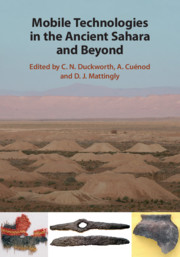Book contents
- Mobile Technologies in the Ancient Sahara and Beyond
- The Trans-Saharan Archaeology Series
- Mobile Technologies in the Ancient Sahara and Beyond
- Copyright page
- Contents
- Figures
- Tables
- Contributors
- Preface
- Part I Introduction
- Part II Technological Mobility and Transfers
- Part III Metallurgy
- Part IV Glass Technology
- Part V Handmade Pottery
- 13 Garamantian Ceramic Technology
- Part VI Conclusion
- Index
- References
13 - Garamantian Ceramic Technology
Change and Exchange in a Trans-Saharan Perspective
from Part V - Handmade Pottery
Published online by Cambridge University Press: 18 September 2020
- Mobile Technologies in the Ancient Sahara and Beyond
- The Trans-Saharan Archaeology Series
- Mobile Technologies in the Ancient Sahara and Beyond
- Copyright page
- Contents
- Figures
- Tables
- Contributors
- Preface
- Part I Introduction
- Part II Technological Mobility and Transfers
- Part III Metallurgy
- Part IV Glass Technology
- Part V Handmade Pottery
- 13 Garamantian Ceramic Technology
- Part VI Conclusion
- Index
- References
Summary
Studies of ceramics in North Africa often favour the analysis of wheel-made over handmade pottery. However, the handmade ceramics are particularly important if we attempt to explore technological transfers within the trans-Saharan region. This chapter presents the ceramic evidence of the Wadi al-Ajal and the Wadi Tanzzuft, two areas of the Libyan Sahara, in order to define the technological characteristics of Garamantian handmade pottery between the first millennium BC and the first millennium AD. After a discussion of the raw materials, shapes and decorations of the pots, the chronological and geographical variations within the Garamantian assemblage are presented. These traits are then compared to pottery from other sites across the Sahara, including some of earlier dates. Finally, drawing on workshop discussions with experts in pottery from across Saharan and West African sites, an attempt is made to analyse the potential transfer of certain traits in a Trans-Saharan perspective, as well as the social context of this transfer. An important result is the identification in Garamantian pottery of roulette decoration, not previously observed so far north. Although connections might be traced between the Sahara and the Sahel from the late pastoral period, experts remain cautious as to their exact nature.
- Type
- Chapter
- Information
- Mobile Technologies in the Ancient Sahara and Beyond , pp. 453 - 484Publisher: Cambridge University PressPrint publication year: 2020

